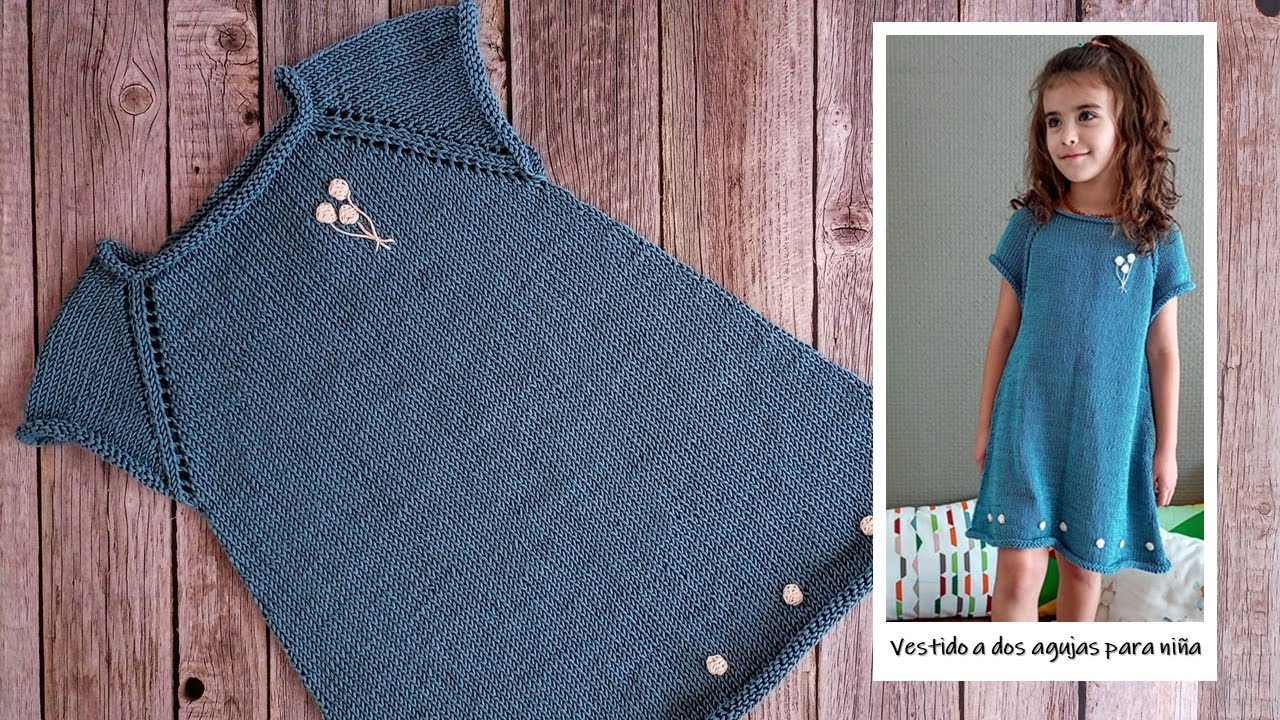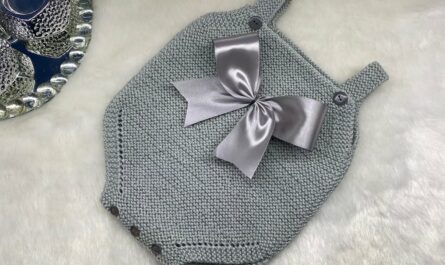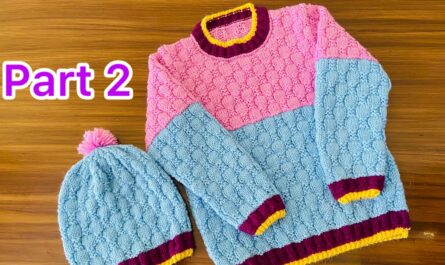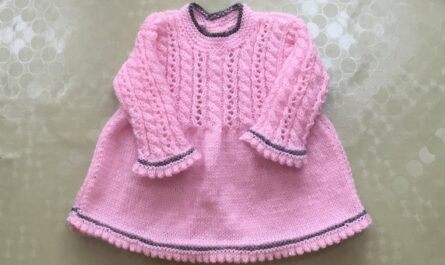Imagine a beautiful dress for a special girl, flowing gracefully, without a single bulky seam to irritate delicate skin. This dream is entirely possible with the magic of seamless top-down crochet. This method starts from the neckline and works its way downwards, creating a continuous piece that minimizes finishing work and allows for unparalleled customization.
Why Choose Seamless Top-Down Crochet for a Girl’s Dress?
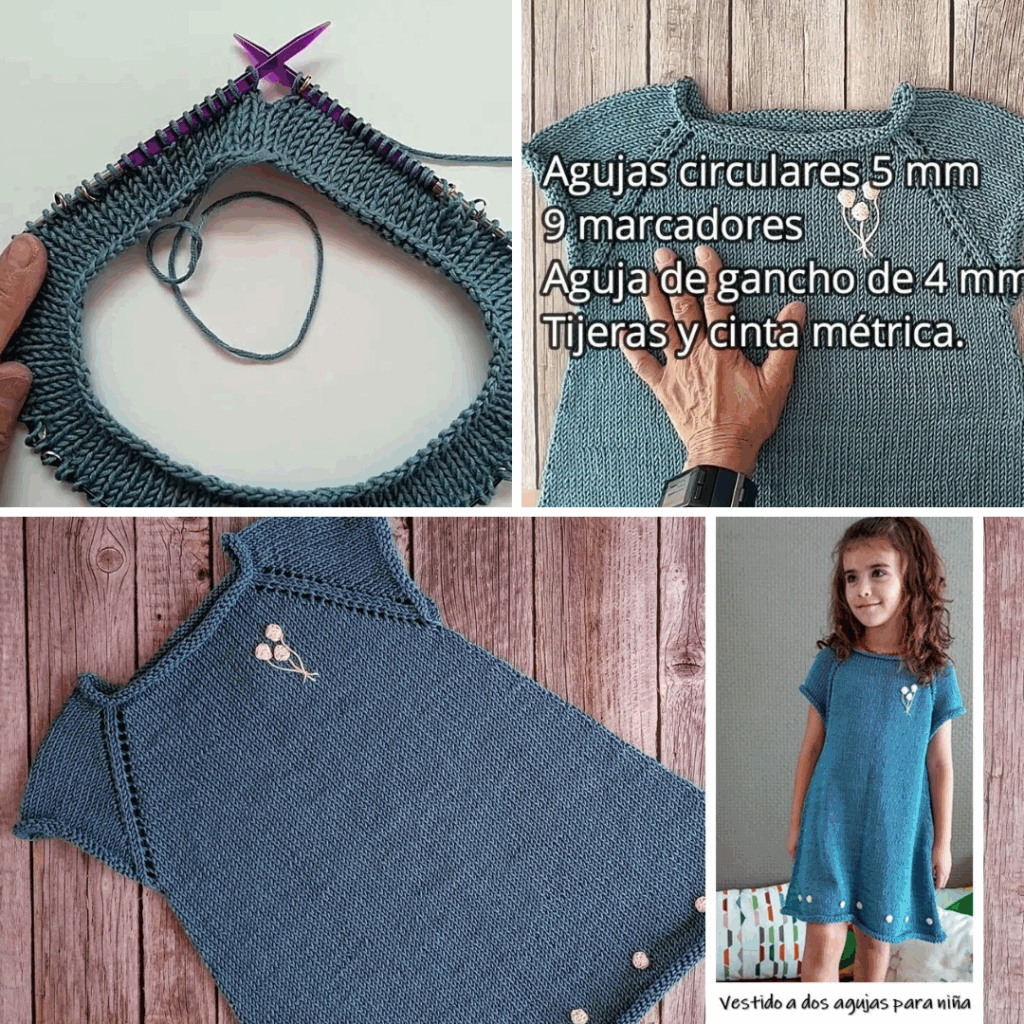
The seamless top-down approach offers a wealth of benefits that make it a favorite among crafters:
- Ultimate Comfort: The absence of seams means no scratchy or irritating bumps against a child’s sensitive skin, making the dress incredibly comfortable for active play and everyday wear.
- Perfect Fit & Easy Customization: As you work from the top down, you can try the dress on the girl (if she’s available) at key points, such as after the yoke is completed. This allows for real-time adjustments to length, width, and sleeve placement, ensuring a perfect fit and accommodating growth spurts.
- Less Finishing Work: One of the greatest advantages is significantly reducing the amount of seaming required. With no separate pieces to stitch together, you save valuable time on finishing and have fewer ends to weave in.
- Efficient Construction: Once the initial yoke shaping is complete, the rest of the dress often becomes a straightforward repetition of stitches, making for a smooth and enjoyable crafting process.
- Skill Building: Tackling a seamless top-down dress will help you master essential garment construction techniques, including various yoke shaping methods (raglan, circular), separating for the body and sleeves, and continuously working in the round.
Decoding the Seamless Dress Aesthetic: Yarn, Hook & Stitch Choices
The beauty and drape of your seamless dress depend heavily on your material and stitch selections.
Yarn Selection: Key to Drape, Durability, & Comfort
Choosing the right yarn is crucial for a comfortable and well-draped dress.
- Weight:
- DK (Double Knitting, Category 3) or Worsted (Category 4): These are incredibly versatile and popular choices. They offer a good balance of warmth, fabric density, and work up at a reasonable pace.
- Sport (Category 2): For lighter, airier dresses, particularly suitable for warmer climates.
- Fiber:
- High-Quality Acrylics (especially “baby” or “soft” blends): Modern acrylics are excellent for children’s clothing. They are incredibly soft, durable, often anti-pilling, available in a vast array of colors, generally hypoallergenic, and (crucially) machine washable and dryable.
- Superwash Merino Wool or Wool Blends: Offers superior softness, warmth, and breathability. The “superwash” treatment ensures machine washability, a significant convenience for kids’ garments. They also have excellent drape.
- Cotton or Cotton Blends: Best for warmer climates due to their breathability and natural feel. They offer great stitch definition but tend to be less elastic than wool or acrylics, so consider this for drape.
- Drape is Paramount: For a dress to hang beautifully and flow with movement, choose a yarn that isn’t stiff. A test swatch will help you determine this.
- Avoid: Yarns that feel scratchy, are very stiff, or have poor drape, as these will result in an uncomfortable and unappealing dress.
Crochet Hook
The hook size will directly impact your fabric’s gauge and drape. Start with the size recommended by your pattern and yarn, but be prepared to adjust significantly based on your gauge swatch to achieve the desired fabric density and drape.
Stitch Patterns: For Flow and Visual Appeal
The key is to select stitches that contribute to a soft, pliable fabric with good drape.
- Main Body Stitches:
- Double Crochet (DC): Works up very quickly and creates a soft, flowing fabric.
- Half Double Crochet (HDC): A good balance of speed and density, offering a lovely drape.
- Textural Stitches (Optional):
- Moss Stitch (Granite Stitch): Creates a subtle, flat texture.
- V-stitch or Simple Shell Stitch: Adds delicate openwork and visual interest without adding bulk or stiffness.
- Ribbing (for Neckline, Cuffs, Hem):
- Single Crochet in the Back Loop Only (SC in BLO): Creates a simple, stretchy ribbing.
- Front Post/Back Post Double Crochet (Fpdc/Bpdc): For a more defined, traditional ribbed look.
- Avoid: Very dense stitches (like tight single crochet throughout) that would create a stiff fabric, or excessively open/lacy stitches unless you specifically intend to line the dress.
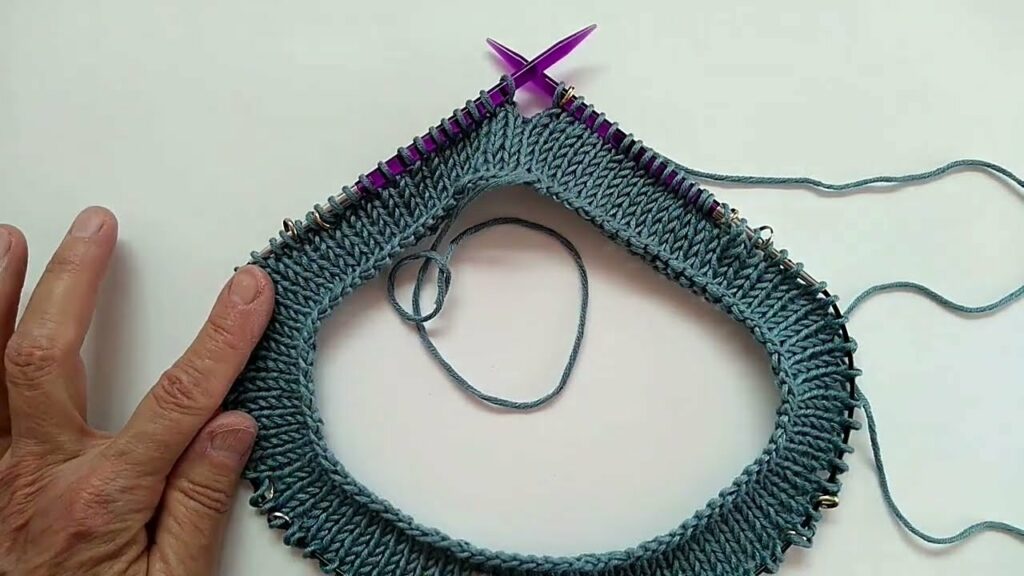
Precision Planning for Your Seamless Dress
Careful planning is the secret to a perfectly fitting garment.
- Accurate Measurements:
- Essential: Do not rely solely on age-based sizing, as children’s sizes vary wildly. Measure the girl’s:
- Chest circumference: Around the fullest part, under the arms.
- Upper arm circumference: Around the fullest part of the upper arm.
- Desired dress length: From the top of the shoulder to where you want the hem to fall.
- Desired sleeve length: From the shoulder to the cuff.
- Neck circumference: Around the base of the neck.
- Ease: Factor in adequate positive ease (typically 2-4 inches for a comfortable, non-snug fit) to allow for movement, layering, and growth.
- Essential: Do not rely solely on age-based sizing, as children’s sizes vary wildly. Measure the girl’s:
- Pattern Selection (CRUCIAL!):
- Highly Recommended: Invest in a well-written, paid or free seamless top-down crochet dress pattern specifically for girls. Reputable sources include Ravelry (a vast database of patterns), designer websites, and major yarn brand sites.
- Look for:
- Clear schematics and sizing charts.
- Precise stitch counts for each size and round.
- Detailed shaping instructions for the yoke, armholes, and body.
- GAUGE INFORMATION: This is non-negotiable. The pattern must provide stitches and rows/rounds per inch/cm.
- Gauge Swatch (ABSOLUTELY NON-NEGOTIABLE!):
- This is the single most critical step for achieving a correctly sized garment.
- Crochet a large swatch (at least 6×6 inches / 15×15 cm) using your chosen yarn and hook in the main stitch pattern that will be used for the dress body.
- Crucial Step: Wash and block your swatch exactly as you would the finished dress. Yarns can behave differently after laundering (stretch, bloom, slightly shrink), and this will affect the final fit.
- Measure your stitches and rows/rounds per inch/cm accurately. If your gauge doesn’t match the pattern’s, adjust your hook size (go up for fewer stitches per inch, down for more stitches per inch) until it matches. Even a small gauge discrepancy will result in a significant sizing error in your finished dress.
Materials You’ll Need
- Yarn: (As detailed previously). The quantity will vary significantly based on the dress size, length, and yarn weight. Be sure to purchase enough from the same dye lot. (Typically 3-8 skeins for a girl’s dress).
- Crochet Hook(s): The size recommended by your pattern, adjusted based on your gauge swatch.
- Notions:
- Stitch Markers: Essential for marking the beginning of rounds, raglan lines (if applicable), increase points, and pattern repeats.
- Tapestry Needle: For neatly weaving in all yarn ends.
- Scissors.
- Measuring Tape: Your constant companion for checking gauge and garment dimensions.
- Stitch Holders or Scrap Yarn: To hold the sleeve stitches while you work the body of the dress.
- Buttons or Snaps (if neckline opening): Choose flat, baby-safe fasteners if applicable.
- Blocking Mats & T-pins: Highly recommended for professional finishing and setting the final shape and drape.
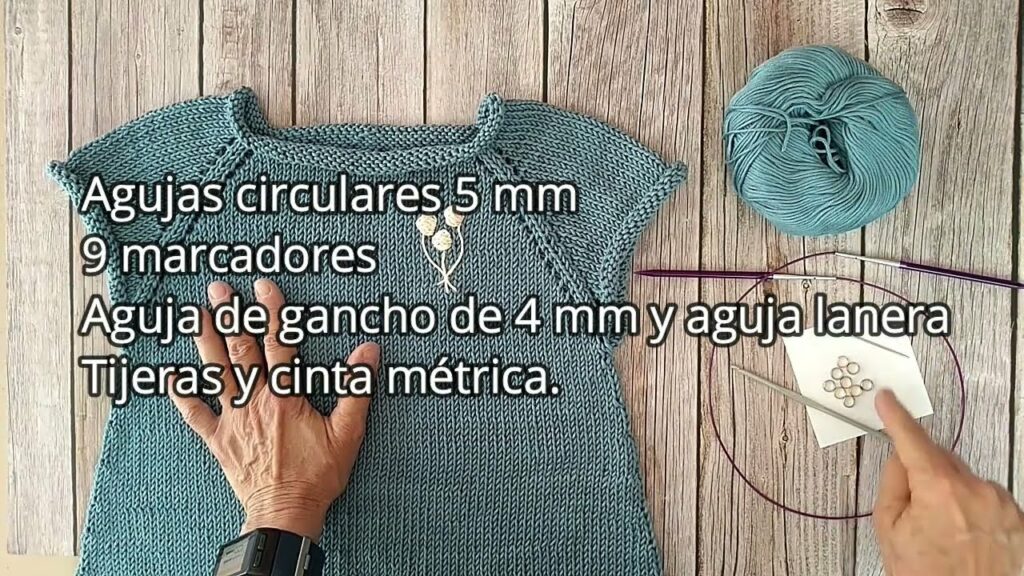
Key Crochet Techniques for a Seamless Top-Down Dress
You’ll utilize foundational crochet techniques along with garment-specific shaping:
- Basic Stitches: Chain (ch), Slip Stitch (sl st), Single Crochet (sc), Half Double Crochet (hdc), Double Crochet (dc).
- Working in the Round: Continuously without turning your work, which creates the seamless fabric.
- Increases: Methods to evenly expand the fabric for the yoke and body. Commonly achieved by working
(2 stitches in one stitch)or specific increase sequences like(dc, ch1, dc)at raglan points. - Decreases (Optional): Used for shaping sleeves or creating a tapered body. Common methods include
sc2tog,hdc2tog, ordc2tog. - Yoke Shaping: Understanding how strategic increases create the desired shoulder slope. Common types include:
- Raglan Yoke: Features distinct increase lines at four points, resembling the seams on a raglan-sleeved shirt.
- Circular Yoke: Increases are distributed more evenly around the circle, creating a rounded, seamless look with no visible “seam” lines.
- Square Yoke: Starts as a square that gradually increases.
- Separating for Body & Sleeves: The crucial point where the yoke is divided, and stitches are held for the sleeves while the body continues.
- Joining Yarn: Techniques for seamlessly joining new skeins of yarn to maintain the continuous fabric.
- Weaving in Ends: Meticulous weaving is essential for comfort, durability, and a clean finish, especially since there are no seams to hide them.
Step-by-Step Seamless Top-Down Construction (Conceptual Guide)
This conceptual guide outlines the general progression for a seamless top-down crochet dress. Always refer to your specific pattern for exact stitch counts and instructions.
- Preparation:
- Thoroughly read through your chosen pattern.
- Make and block your gauge swatch.
- Gather all your yarn, hooks, and notions.
- Foundation & Neckline:
- Begin with the specified foundation chain or a chainless foundation stitch for the neckline circumference.
- Back Opening (Optional but Recommended for Ease): For easier dressing, especially for smaller girls, many patterns will instruct you to work the first few yoke rows flat (back and forth) creating a small opening at the back of the neck. If so, you’ll incorporate simple chain-space buttonholes on one side of this opening as you go.
- Work the initial neckband (if specified by your pattern) or proceed directly to the first few rows of the yoke.
- Yoke Construction & Shaping:
- This is the most critical part for achieving a good fit around the shoulders and chest. The pattern will precisely guide you on where and how to increase stitches to form the yoke.
- Yoke Type: Follow the pattern for your chosen yoke style (raglan, circular, or square).
- Increasing: Carefully place your increases as indicated by the pattern. Use stitch markers to mark raglan lines or the start/end of increase sections.
- Measuring: Continuously measure the yoke as it grows. The pattern will provide instructions on when the yoke should reach a specific circumference (around the chest and upper arm) before proceeding to the next step. You should be able to try the yoke on the girl at this point to check the fit.
- Continue working the yoke, following the increase pattern, until it reaches the specified dimensions for the chest and upper arm.
- Separating for Body & Sleeves:
- At the appropriate point, when the yoke fits comfortably around the chest and shoulders, the pattern will instruct you to:
- Place the stitches designated for the sleeves onto stitch holders or a long piece of waste yarn. These stitches will be worked later.
- “Cast on” (or chain) a few stitches under each arm. This creates the underarm space and connects the front and back body sections.
- Join the front and back body sections together to begin working the main body of the dress.
- At the appropriate point, when the yoke fits comfortably around the chest and shoulders, the pattern will instruct you to:
- Crochet the Body of the Dress:
- Continue working in the round (or flat, if your back opening extends down the entire length of the dress) for the desired length.
- Your pattern might include shaping for a slight A-line flare (through gradual increases) or just be a straight tube.
- Once the desired length is reached, finish the bottom with a border or hem (e.g., ribbing, a simple shell edging, or a few rows of SC).
- Crochet the Sleeves (Optional):
- Go back to the held sleeve stitches.
- Join your yarn at the center of the underarm (where you chained stitches in step 4).
- Work the sleeves in the round, decreasing stitches if necessary to create a taper, until the desired sleeve length.
- Finish the cuffs with an edging (e.g., ribbing or a simple border).
- Repeat for the second sleeve.
- Finishing:
- If you created a back opening, complete the placket or button band by adding any final border rows.
- Securely attach baby-safe buttons or snaps, ensuring they are sewn on very firmly to prevent choking hazards.
- Weave in any remaining yarn ends meticulously using your tapestry needle. Since there are no seams to hide them, neat weaving is crucial.
- Blocking:
- Gently wash or wet the entire finished dress according to your yarn’s care instructions.
- Carefully block the dress. Lay it flat on blocking mats, gently stretch it to the desired final dimensions, and secure it with T-pins. Allow it to air dry completely. Blocking truly transforms the finished piece, making it lie flat, evening out stitches, and enhancing the drape and overall professional look.
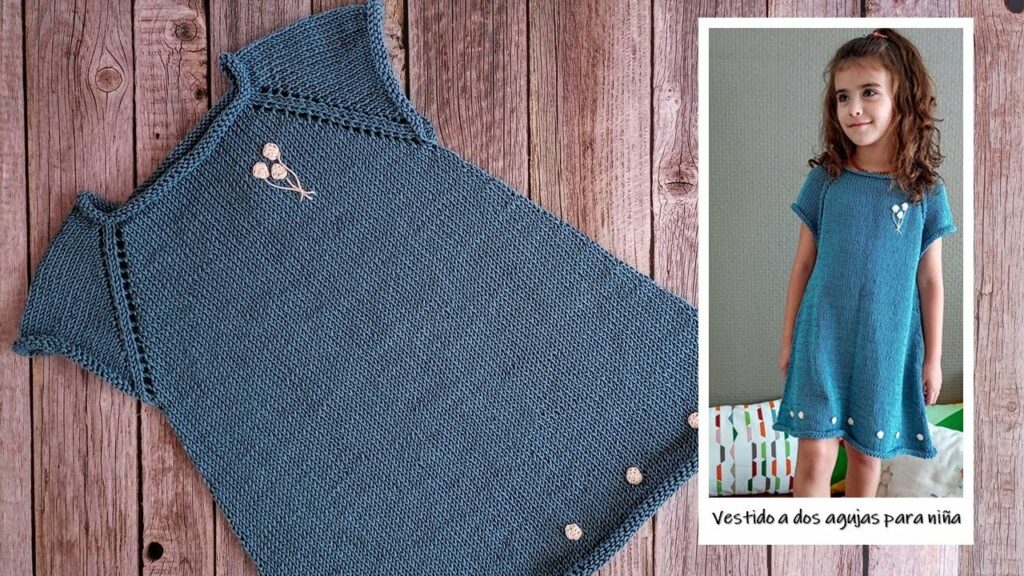
Tips for Seamless Success
- Read the Pattern Meticulously: Don’t skim. Understand every instruction, especially for increases, decreases, and yoke separation points.
- Don’t Skip the Gauge Swatch! This is paramount for achieving the correct fit for any garment, especially a seamless one where errors can accumulate.
- Use Stitch Markers! They are invaluable for marking the beginning of rounds, raglan lines, increase points, and specific pattern repeats.
- Count Your Stitches! Make it a habit to regularly verify your stitch counts at the end of every round, particularly after increase rounds and before separating for the body and sleeves. Catching errors early saves immense frustration later.
- Choose Yarn with Good Drape: A seamless dress needs to flow and move with the wearer, not stand stiffly.
- Try It On (if possible): If the girl is available, try the dress on after the yoke is done and again when the body length is almost complete. This is the beauty of top-down construction!
- Weave in Ends Meticulously: Since there are no seams to hide them, taking extra care with weaving in ends is crucial for both aesthetics and durability.
- Blocking is Your Best Friend: Don’t skip this step! It truly transforms the finished piece, making stitches even, enhancing drape, and setting the final shape.
Caring for Your Crocheted Dress
Proper care will ensure your handmade dress remains beautiful and comfortable for years to come:
- Follow Yarn Label Care Instructions Strictly: This is your primary guide for appropriate washing and drying methods for your specific yarn.
- Gentle Washing: Most crochet garments made with machine-washable yarn should be machine washed on a gentle or delicate cycle with cool water. For very delicate yarns, hand wash gently in cool water with a mild detergent.
- Reshape and Lay Flat to Dry: Gently squeeze out excess water (never wring or twist the garment!). Reshape the dress back to its original dimensions and lay it flat on a clean towel or a mesh drying rack to air dry completely.
- Never Hang Wet: The weight of a wet crocheted garment will cause it to stretch and distort significantly if hung to dry.
Conclusion
Crocheting a seamless top-down dress for a girl is a truly magical and empowering experience. While the term “two-needle crochet” might cause initial confusion (as crochet uses a single hook), mastering the seamless top-down method with your one trusty hook opens up a world of beautifully draped, comfortable, and customizable handmade garments. Embrace the flow, enjoy the process, and delight in the stunning dress you create for the special girl in your life!
Video Tutorial ;
